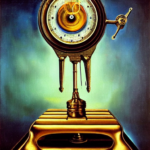The importance of practicing with a metronome

Ah, the metronome. That little ticking timekeeper that has the power to make or break a musician’s performance. As a seasoned shredder myself, I can attest to the importance of mastering the metronome.
You see, the metronome serves as a constant and steady pulse for musicians to follow. It helps us keep time and ensures that we are playing in a precise and consistent manner. However, when used correctly, the metronome does a lot more than help you keep time… it gives you a way to map and measure your progress. That’s one of the secrets that allow musicians to reach virtuoso levels with their technique.
manner. However, when used correctly, the metronome does a lot more than help you keep time… it gives you a way to map and measure your progress. That’s one of the secrets that allow musicians to reach virtuoso levels with their technique.
It can be used to practice everything from scales and modes to arpeggios and advanced techniques such as sweep picking.
Auto Amazon Links: No products found. http_request_failed: A valid URL was not provided. URL: https://ws-na.amazon-adsystem.com/widgets/q?SearchIndex=All&multipageStart=0&multipageCount=20&Operation=GetResults&Keywords=B0B12CJC6G&InstanceId=0&TemplateId=MobileSearchResults&ServiceVersion=20070822&MarketPlace=US Cache: AAL_6b57aab0b6f3cf38e94813c75b329d6f
What can metronome practice do for your playing?
By starting at very slow speeds, you can practice something in such a way that every note is clear and precise. As important is the fact that you can find a tempo where you won’t make any mistakes. This allows you to build the best playing habits, cement your muscle memory and develop flawless technique. Then you can gradually increase the tempo, not only increasing the speed of the section you’re practicing but the flawless precision and articulation as well.
But for many musicians, including myself in my younger days, the metronome can be a source of frustration. It’s easy to get flustered when trying to keep up with that darn tick-tock, especially when you’re trying to play something fast and complex.

Mastering the metronome
If you’ve been reading my blog for awhile then you know that I’ve studied a number of guitar courses by Shred Master Dan Mumm and I also follow his mailing list. He has a fantastic formula for practicing with the metronome that makes it possible to learn and master just about anything you can imagine.
I personally used his formula to master everything from Paganini style runs to complex sweep arpeggios like the ones Dan teaches towards the end of his course, Sweep Picking Mastery.
Dan Mumm’s Proven Metronome Formula
With practice and patience, you too can master the metronome and take your playing to new heights. Here’s Dan Mumm’s metronome practice method, in his own words:
Step 1: Find a BPM setting on your metronome that allows you to play the exercise with perfect articulation and timing. It will be very slow on the first day.
Step 2: Repeat the exercise, with the metronome, until you play 5 perfect renditions in a row. The slightest mistake means you start the count over again.
Step 3: Raise the tempo on your metronome by 2 BPM.
Step 4: Repeat steps 2 through 4 until you can’t go further.
Step 5: Stop for the day and start again tomorrow from Step 1. Always start slower than you left off the day before
Using a metronome that is easy for you to adjust is really important as well. I personally prefer using a mechanical metronome like the one I will add a link to below. As far as I’ve seen, Dan hasn’t revealed what type of metronome he prefers, but I don’t think it matters too much as long as it works properly and is easy for you to adjust while practicing.
Auto Amazon Links: No products found. http_request_failed: A valid URL was not provided. URL: https://ws-na.amazon-adsystem.com/widgets/q?SearchIndex=All&multipageStart=0&multipageCount=20&Operation=GetResults&Keywords=B01IP8C04M&InstanceId=0&TemplateId=MobileSearchResults&ServiceVersion=20070822&MarketPlace=US Cache: AAL_ee938cf2b0906d05feb3aaa0215f7f35
How much time do you think he spent with the metronome to play this?
Anton’s Metronome tips

I have some tips to share with you of my own that I’ve realized over the course of my own progress working with a metronome:
- Follow the above formula: It’s tempting to want to jump right into playing at top speed, but this is a recipe for disaster. Start slowly and gradually increase the tempo as you get more comfortable. This will help you build a solid foundation and establish good time-keeping habits.
- Practice with a drum loop: If you’re new to using a metronome and having difficulty locking into to time with it, use a drum loop, drum machine or drum track instead. This can be a great way to get a feel for the metronome and work on your timing but it also can be used in place of a metronome if you can easily adjust the tempo in the same fashion. It’s also a helpful way to get used to playing with other musicians, as the drums provide a steady pulse to follow.
- Use the metronome in all of your practice sessions: It’s easy to neglect the metronome when practicing, but it’s important to incorporate it into all of your practice sessions, not just when you’re working on specific pieces. This will help you develop a natural sense of timing and groove.
- Don’t be afraid to experiment: The metronome isn’t the be-all and end-all of time-keeping. Don’t be afraid to experiment with different settings and see what works best for you. If you need to start at 60 beats-per-minute to follow the formula above, but the ticks are too far apart for you to lock into, set the metronome to 120 instead. That way you’d have twice as many ticks while still practicing at the same actual speed. Be careful with this if you’re working with triplets, however. You may need to do a little math to figure it out, but it’s worth it.
In conclusion, mastering the metronome is an essential skill for any musician, but it takes time and practice. Don’t get discouraged if you struggle at first, it’s all part of the learning process. Keep at it and soon enough, you’ll be keeping time like a pro.
Shred on!
